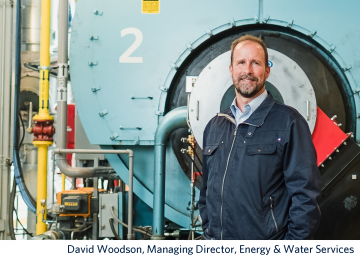
As UBC’s managing director of Energy and Water Services, David Woodson is deeply involved managing how energy on the Vancouver campus is generated, distributed conserved and consumed to help the university hit its aggressive greenhouse gas (GHG) emissions reduction target: a 67 per cent reduction from 2007 levels by 2020.
The Bioenergy Research Demonstration Facility (BRDF), which opened in 2012, is the inspiration behind the university’s energy transformation. A first of its kind project in North America, the system transforms clean wood waste from regional wood product manufacturing and municipal plant trimmings to generate thermal energy for heating campus buildings. The existing plant has already cut the university’s CO2 emissions by around 8,500 tons per year and has contributed a 14 per cent reduction in UBC’s GHG emissions since 2007. It is a major contributor to UBC’s overall GHG emissions reduction of 38 per cent (in 2018).
As a mechanical engineer and a UBC MBA graduate, David understands the benefits of linking research and operations to showcase, refine and create new technologies that benefit the university community and communities beyond:
“The BRDF has been exciting and successful in so many ways!” says David. “It was the first physical manifestation of the university’s Campus as a Living Laboratory philosophy. My team had an operational need to provide heat to the university community and reduce emissions, the Faculty of Applied Sciences had an interest in performing research in related areas. Together, they were able to create a platform where not only operational goals of reduced greenhouse-gas emissions, operational efficiencies and reduce costs were achieved, but researchers were given direct access to lab space within the facility for collaboration on initiatives for mutual benefit.”
Now, the BDRF is embarking on a $20.4 million expansion, with $7.6 million in funding from the federal government’s low-carbon economy fund. By late fall 2020, the new 12 MW biomass fuelled hot water combustion boiler will generate 70 per cent of the hot water needed in UBC’s district energy system. It will reduce natural-gas use by half, cut CO2 emissions by 14,500 tonnes per year, and save more than $1M in annual operating costs.
“If all goes as projected, the expansion will bring us to a 63% overall GHG reduction,” says David. “So our next question is how do we hit 67%; what are the small projects we can make happen? And then, of course, how do we hit 100%? This is not far-fetched: the new plant will meet all of our energy needs for nine months of every year, so we need to think about ways to address those high-demand winter months.”
The expanded facility will also include the new $4.5M Canada Foundation for Innovation (CFI)-funded Biorefining Research and Innovation Centre. There, researchers will develop and demonstrate the next-generation technologies to convert biomass to clean syngas, hydrogen, renewable natural gas and liquid biofuels, allowing the BDRF to potentially generate electricity as well as heat.
David’s team of subject matter experts in energy and utility systems is part of the Facilities group within the Vice-President Finance & Operations portfolio. Their work has been recognized internationally:
“This year, UBC was recognized on the Times Higher Education University Impact rankings as number one in the world for our climate change efforts. The Government of Canada’s investment in the expansion of UBC’s Bioenergy Research & Demonstration Facility will help UBC maintain our global leadership and move us significantly closer to our goal of zero carbon emissions on the UBC Vancouver campus,” says Peter Smailes, Vice-President, Finance & Operations.
David is very interested in expanding the Campus as a Living Laboratory program and hopes faculty researchers will contact him with ideas:
“A lot of researchers on our campus don’t realize that they can take advantage of the opportunities available when working with the operational side of the university,” adds David. The BDRF project highlights how much could be done when faculty and staff work together on pressing sustainability issues.”